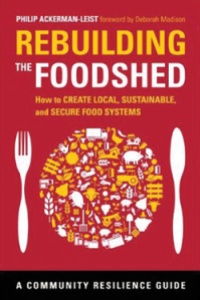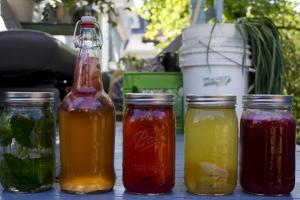Secession: As American As Apple Pie (NATIONAL JOURNAL)
September 30, 2014Global Roots, Local Flavor: The Vermont International Film Festival. (FILM)
September 30, 2014Rebuilding Our Foodshed: Wisdom from the Green Mountains, by Alanna Moriarty (BOOK REVIEW)
Twenty-first century U.S. food production systems are harming us, its citizens, more than helping us. In the past five years, the terms “locally grown” and “organic” have become buzzwords for those trying to eat in a healthier and more environmentally friendly way. But what does “locally grown” really mean? Are we all expected to become backyard farmers? It is often debated whether the economic and ecological costs of buying locally produced food really outweigh those of buying from traditional supermarkets. What is the true price of these massive corporate food production methods on our cultures, our wildlife, and our communities? Philip Ackerman-Leist, author and Green Mountain College professor, suggests we go back to basics and rebuild our eating habits, and our communities, quite literally from the ground up.
In his new book, Rebuilding the Foodshed: How To Create Local, Sustainable and Secure Food Systems, one of the first issues Ackerman-Leist raises is how “local” local really is. Is it just about geography? Before you answer that, consider this: where do you consider “home”? Why? Is it just because that is where your house is? Probably not. We humans tend to feel at home in places where we have made connections; and Ackerman-Leist is all about connections. When we feel a physical, emotional attachment to a town, state, or region, we like to take ownership of it. This is where local food appeals to us. Vermont FEED, one of the first farm-to-school systems and food education programs, focuses on bringing the food conversation to “the three C’s: cafeteria, classroom, and community.” The program reminds Vermonters that there are many benefits to supporting local agriculture; economically, environmentally, and nutritionally. As many of us know very well, education is the first step to change.
It’s not just about facts and figures, miles and minutes of travel, gas consumption and greenhouse gasses. It is much more personal than that: the feeling of biting into a fresh, crisp apple may take you back to apple-picking with your family when you were 10. Or the smell of melting mozzarella makes you yearn for your mother’s lasagna. It is a deep cultural and familial connection to what we eat, how we eat and prepare it, and how we feel while doing it. Think of Italy, for example. What is the first image that pops into your mind? For me, it is fresh garlic, tomato sauce, and warm home cooking. It is the feeling that I am missing out on something essential if I do not visit the country, and try these things while I am there. Or, to bring it closer to home, think of the Deep South. Louisiana gumbo, hand-battered fried chicken, home-grown strawberry jams; all are an indispensable part of the local culture. Even Vermont has maple syrup…and maple candies, maple lemonade, maple cotton candy…you get the point. As Ackerman-Leist says, it’s idea that “we can never truly experience a place until we taste a particular fruit, a time-honored dish, a unique spirit, any of which may be replicated elsewhere but diminishes in authenticity with every mile it travels.”
The current mentality of the United States is that “food can be grown elsewhere.” But why does it have to be? We have some of the most fertile, arable land here in the U.S., but it is being targeted for urban development. Instead of using these vast expanses of beautiful land to help sustain us, we are building more property that we don’t need, killing wildlife and ecosystems, and utterly destroying the landscape. Urban development also has its own issues. Have you ever heard of a food desert? Neither had I until about this time last year. A food desert describes an urban or suburban area that has no access to grocery stores, and instead must rely on convenience marts and beverage shops for food. Not very healthy, is it? Nor it is affordable: these neighborhoods are mostly populated by “racially diverse workers so critical to our food production system,” and yet they are living off wages that do not even allow them to adequately feed their own families. Take, for example, Birmingham, Alabama. Yes, a bustling city smack in the middle of one of the most food-centric cultures in the United States has areas where access to fresh, nutritious food is nearly impossible. To combat this, a woman named Taylor Clark began the Urban Food Project to support local food production. It is difficult to introduce any kind of urban farming in Birmingham, as there is a cultural bias toward unhealthier food, such as the fried chicken I mentioned earlier. Additionally, it is an area where poverty is prevalent, and many cannot afford to buy local produce, or sometimes any produce at all. But bringing healthy, sustainably-raised food to markets like these, Clark admits, can be slow. Theresa Snow, a graduate of Sterling College, has taken steps to increase food security in Vermont as well. In 2005, she co-founded Salvation Farms, a nonprofit that would absorb and redistribute surplus fruits and vegetables throughout northern Vermont. She works very closely with the Vermont Food Bank to increase food security and create community-based solutions to aid food accessibility.
But what about distance? What is the effect of actual miles traveled over physical land, via tractor trailer, plane, ship, or a local farmer’s pickup? The food we eat requires energy: electricity and fertilizer to grow, to harvest, to package, to ship, to prepare, to cook, to dispose of. That’s a lot of energy. Ackerman-Leist explains it this way: say each food serving gives us one calorie. It takes between seven and ten “calories” to produce that one serving. That a little but outrageous, no? That it takes seven to ten times more energy to produce a food serving than said food serving actually gives us. So how do we combat this obscene energy imbalance? Ackerman-Leist gives a few options, and describes what the most effective food production companies do. The biggest food suppliers use hybrid and fuel-efficient vehicles, computerized pickup and delivery systems that monitor supply and demand, supply food regionally rather than strictly locally, use local aggregates like Co-ops (or “food hubs”), and some workplaces even sponsor “community-supported agriculture” programs where food is regularly delivered to one work building for the benefit of many people. But what about waste? As much as we would like to believe otherwise, most of us buy too much food, or don’t eat our leftovers before they go bad. As Ackerman-Leist says, “it may not be the sexiest consideration, but it’s the most important.” After all, food wasted is energy wasted. In my hometown of West Boylston, MA, a composting initiative was started about five years ago. Like other towns nationwide, we had to buy special, more costly trash bags that would be picked up by our waste management trucks. This was supposed to encourage more recycling and composting and less willy-nilly tossing of reusable products. Vermont also has a similar “soil-to-soil” program to build a statewide food system over the next decade (from 2013-2023). It is the hope of environmentalists that programs like these will not only reduce energy consumption, but also packaging and waste products.
Of course, these are just a few ways in which we can all pitch in to rebuild our nation’s food production systems. The less we rely on CAFOs (confined animal feeding operations) and pesticide-pitching “factory farms,” the more we help our environment and our fellow Americans. Local and regional food systems don’t just encourage healthy lifestyles and a sense of community, but also food justice. There would be no workers doing dangerous jobs (like slaughtering animals on an assembly line) for wages that do not even cover the cost of their own dinner. It may be idealistic, but imagine if we all had a handful of local farmers and cooperatives that allowed us access to nutritious, affordable, delicious fresh food. We would have a sense of community with our neighbors, and feel more attached to where we live. It’s not just about the environment, fossil fuels, or our next meal. Local and sustainable food systems are about us, our impact, and our future.
Read more revolutionary writing at Chelsea Green Publishing.
Share this:
- Click to print (Opens in new window)
- Click to email a link to a friend (Opens in new window)
- Click to share on Twitter (Opens in new window)
- Click to share on Facebook (Opens in new window)
- Click to share on Reddit (Opens in new window)
- Click to share on LinkedIn (Opens in new window)
- Click to share on Tumblr (Opens in new window)


